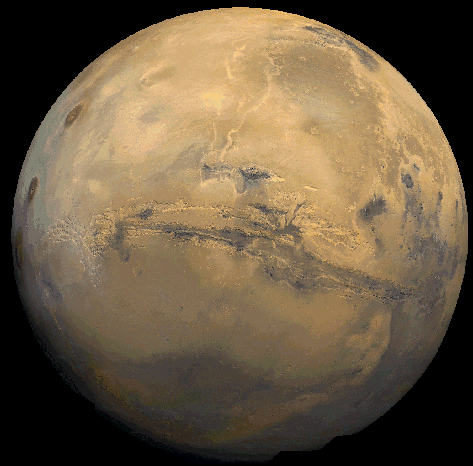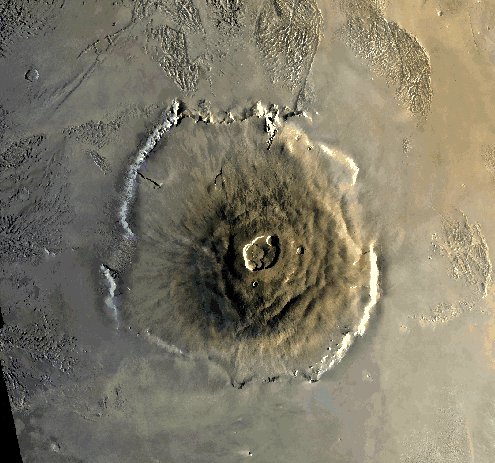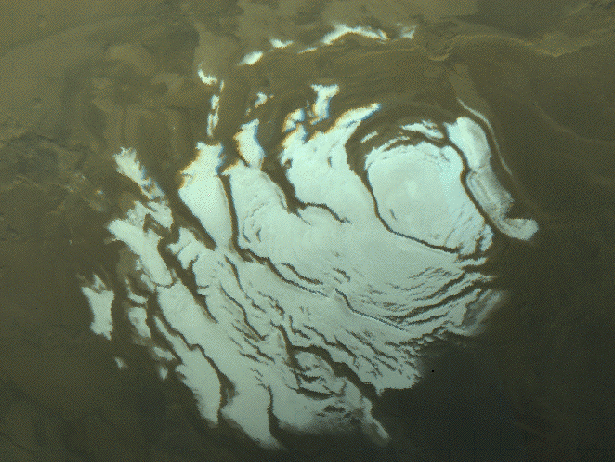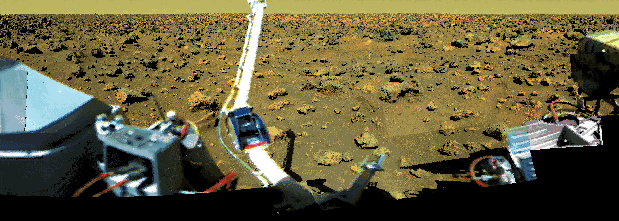Mars: A Century of Exploration
Geologic Features
 This mosaic of Mars is similar to the view you would see from a spacecraft. The
center of the scene shows the entire Valles Marineris canyon system, over 4000
km (2486 mi) long and up to 7 km (5 mi) deep. It extends from Noctis
Labyrinthus, to the chaotic
terrain on the east side. Many ancient river channels begin from the chaotic
terrain and north-central canyons and run north. Three Tharsis volcanoes are
visible to the west (dark red spots). They rise 10 to 18 km (6 to 11 mi) above
the Tharsis Plateau, attaining elevations of 18 to 26 km (11 to 16 mi).
This mosaic of Mars is similar to the view you would see from a spacecraft. The
center of the scene shows the entire Valles Marineris canyon system, over 4000
km (2486 mi) long and up to 7 km (5 mi) deep. It extends from Noctis
Labyrinthus, to the chaotic
terrain on the east side. Many ancient river channels begin from the chaotic
terrain and north-central canyons and run north. Three Tharsis volcanoes are
visible to the west (dark red spots). They rise 10 to 18 km (6 to 11 mi) above
the Tharsis Plateau, attaining elevations of 18 to 26 km (11 to 16 mi).
 Nearly half of the Valles Marineris canyon system is visible here. The entire
system extends over 4000 km (2490 mi), covering about one fifth the
circumference of Mars. Some parts of the canyon run as deep as 7 km (4 mi)
and
as wide as 200 km (125 mi). Compared to Valles Marineris, the Grand Canyon on
Earth seems quite small at 446 km (277 mi) long, 30 km (18 mi) wide and 1.6 km
(1 mi) deep.
Nearly half of the Valles Marineris canyon system is visible here. The entire
system extends over 4000 km (2490 mi), covering about one fifth the
circumference of Mars. Some parts of the canyon run as deep as 7 km (4 mi)
and
as wide as 200 km (125 mi). Compared to Valles Marineris, the Grand Canyon on
Earth seems quite small at 446 km (277 mi) long, 30 km (18 mi) wide and 1.6 km
(1 mi) deep.
 Olympus Mons is the largest volcano on Mars. This shield volcano, similar to
volcanoes in Hawaii, measures 624 km (374 mi) in diameter by 25 km (16 mi)
high. It is 100 times larger than Mauna Loa on Earth. Located on the Tharsis
Plateau near the equator, Olympus Mons is bordered by an escarpment. The
caldera in the center is 80 km (50 mi) wide and contains multiple circular,
overlapping collapse craters created by different volcanic events. The radial
features on the slopes of the volcano were formed by overflowing lava and
debris.
Olympus Mons is the largest volcano on Mars. This shield volcano, similar to
volcanoes in Hawaii, measures 624 km (374 mi) in diameter by 25 km (16 mi)
high. It is 100 times larger than Mauna Loa on Earth. Located on the Tharsis
Plateau near the equator, Olympus Mons is bordered by an escarpment. The
caldera in the center is 80 km (50 mi) wide and contains multiple circular,
overlapping collapse craters created by different volcanic events. The radial
features on the slopes of the volcano were formed by overflowing lava and
debris.
 This mosaic of Viking Orbiter frames shows the South Polar Cap of Mars. The
polar cap is composed of water and carbon dioxide ice. The ice appears reddish
due to dust that has been incorporated into the cap.
This mosaic of Viking Orbiter frames shows the South Polar Cap of Mars. The
polar cap is composed of water and carbon dioxide ice. The ice appears reddish
due to dust that has been incorporated into the cap.
 This Viking Lander 2 site has stones which were probably ejecta from impact
craters
near the Lander 2 site. Many of the rocks are angular and are thought to be
only slightly altered by the wind and other forms of erosion. The overall red
coloring of the Martian terrain is due to the presence of oxidized iron in the
regolith (dirt). The pink color of the sky is caused by extremely fine red dust that
is suspended in Mars' thin atmosphere.
This Viking Lander 2 site has stones which were probably ejecta from impact
craters
near the Lander 2 site. Many of the rocks are angular and are thought to be
only slightly altered by the wind and other forms of erosion. The overall red
coloring of the Martian terrain is due to the presence of oxidized iron in the
regolith (dirt). The pink color of the sky is caused by extremely fine red dust that
is suspended in Mars' thin atmosphere.
Before discussing a crewed mission to Mars, lets take a virtual flight over
the Martian surface, The following video is "Mars: The Movie" by the Jet
Propulsion Laboratory. [At this time, the movie is played in the actual
planetarium show - it's about 5 minutes long.]
Go to
next section.





